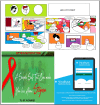The 4 youth by youth HIV self-testing crowdsourcing contest: A qualitative evaluation
- PMID: 32469971
- PMCID: PMC7259504
- DOI: 10.1371/journal.pone.0233698
The 4 youth by youth HIV self-testing crowdsourcing contest: A qualitative evaluation
Abstract
Introduction: Crowdsourcing, a participatory approach to solicit ideas from a large group of diverse individuals, provides an opportunity to nurture youth participation in HIV self-testing service design. The objective of this study was to describe the responses to a crowdsourcing contest aimed at soliciting ideas on how to promote HIV self-testing (HIVST) among young people in Nigeria.
Methods: The "4 Youth by Youth" HIV Self-Testing Crowdsourcing contest was an online and off-line contest that asked Nigerian youth (10-24 years old) for ideas in response to the following: How might we promote HIVST among young people in Nigeria? All data were collected and analyzed between October 2018, and June 2019. Ideas and perceptions generated from the crowdsourcing contest were qualitatively analyzed using thematic content analysis. Specifically, four reviewers analyzed whether the ideas generated were desirable (appealing to young people), feasible (easy to implement) and impactful (will significantly influence HIVST uptake among young people).
Results: A total of 903 entries were received in response to the contest prompt. Participants submitted entries in various forms: online form (39.7%), offline Dropbox (44.6%), email (6.1%) and WhatsApp (9.7%). Of the total entries, 85% (n = 769/903) entries were eligible and were scored as having either high, moderate or low level of feasibility, impact and desirability, on a 3-point Likert scale. A significant portion of the entries were given a score of 3 for feasibility (4.9%), desirability (7.1%), impact (3.0%) or a total overall score of 7 or more (8.2%). The three main themes that emerged from the entries include:1) Peer-to-peer distribution and leveraging on existing infrastructures 2) Youth-Oriented Branding of the HIVST Kit 3) Mobile platforms and social media technology.
Conclusion: The "4 Youth by Youth" Self-Testing contest engaged a broad audience of young people to generate ideas and perspectives on how to promote HIVST. This process informed the development of youth innovated implementation strategies to increase uptake of HIVST among adolescents and youth at risk for HIV.
Conflict of interest statement
All authors declare that they have no competing interest.
Figures
References
-
- Bekker L-G, Hosek S. HIV and adolescents: focus on young key populations. Journal of the International AIDS Society. 2015;18(2(Suppl 1)):20076.
-
- NDHS. National Population Commision; Nigerian Demographic and Health Survey Reports. 2013.
-
- Sam-Agudu NA, Folayan MO, Ezeanolue EE. Seeking wider access to HIV testing for adolescents in sub-Saharan Africa. Pediatric research. 2016;79(6):838. - PubMed
-
- Babalola S. Readiness for HIV testing among young people in northern Nigeria: the roles of social norm and perceived stigma. AIDS and Behavior. 2007;11(5):759–69. - PubMed
Publication types
MeSH terms
Grants and funding
LinkOut - more resources
Full Text Sources
Medical


